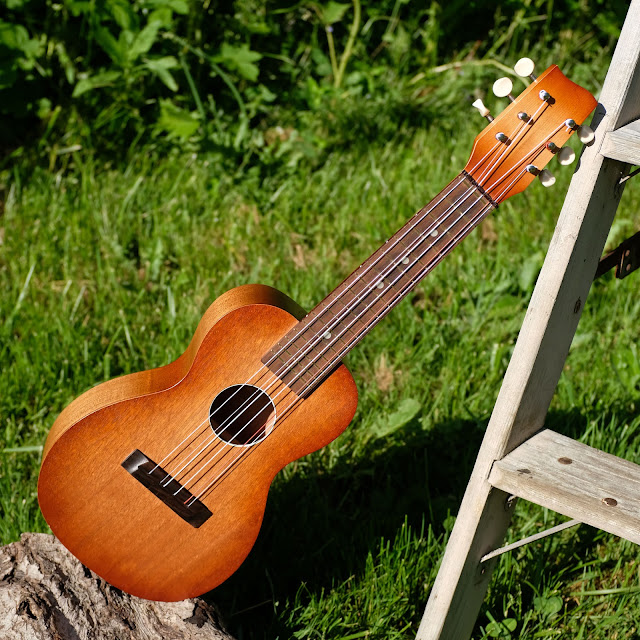2000s Bruko 6-String Concert Ukulele (Conversion)
A customer of mine sent in this fella (which began as a guitalele/guilele with 6 individual strings) for conversion to a 6-string concert uke along the lines of a Kamaka Liliu. It was a straightforward modification -- shave the bridge down, fill the old mounting slots, make a new string-mounting method, fill and re-slot the nut, a fret level/dress, and setup with a new set of Aquila strings (featuring a "red" string rather than a wound low A).
I'm happy with the result tone-wise, though the Germanic origins of this Bruko uke definitely give it that sort-of sturdy brightness I expect from instruments out of that vicinity. It suits the octave stringing on the C and A courses, though, and gives them good clarity. It's hard to beat that iced-tea sunburst finish, too!
As far as actually playing one of these 6-string ukes -- it takes a bit to wrap the head around it as your lowest string is actually the low-octave A on the "highest" course. The "highest" string is now the chimey high C on what used to be your "lowest" course. Oh my...! I can see why this stringing was used, though, as the low A gives a nice extra bass note to chordal strumming that suits common open-fingered chords.
Specs are: 14 1/16" scale, 1 5/8" nut width, 1 3/8" string spacing at the nut, 1 13/16" spacing at the bridge, 8" lower bout, 6" upper bout, and 2 1/2" side depth. The neck is a medium D-shape with a flat fretboard and the action is dialed-in to just a hair above 1/16" at the 12th fret.
Specs are: 14 1/16" scale, 1 5/8" nut width, 1 3/8" string spacing at the nut, 1 13/16" spacing at the bridge, 8" lower bout, 6" upper bout, and 2 1/2" side depth. The neck is a medium D-shape with a flat fretboard and the action is dialed-in to just a hair above 1/16" at the 12th fret.
The zero fret is a nice thing to have, though Bruko did install an oversize one which is a clear no-no in the design world but is so-often-executed it hurts my head. All those frets should be the same height/size when installed!
I also had to give the instrument a fret level/dress as the neck had gained a hair of warp over its lifespan and that, for all intents and purposes, allowed me to remove it via the tops of the frets.
My mod to the bridge includes string-through mounting. The idea here is to push the strings in from the top until they curl-up enough inside that you can grab the end through the soundhole to knot into a ball-end. From there you can then pull it up snug against the bridge plate and up to the tuner post.













Comments
Thanks for sharing, you did a great job! I loved the sound resulted...